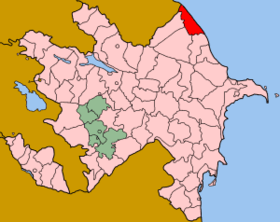Khachmaz District
Khachmaz (Azerbaijani: Xaçmaz rayonu, Lezgian: Хъачмаз район) is one of administrative divisions of Azerbaijan. It is about 10 km from the Caspian Sea, below Khudat, and to the east of Quba. Khachmaz is 170 kilometres north of the capital Baku. The Khachmaz rayon borders the Republic of Dagestan of the Russian Federation.The villages of Uryanoba and Kharakhoba were exclaves belonging to Russian Federation, Republic of Dagestan.[1][2]
Khachmaz Rayon Xaçmaz rayonu Хъачмаз район (in Lezgian) | |
|---|---|
City | |
 Map of Azerbaijan showing Khachmaz Rayon | |
| Coordinates: 41°28′N 48°48′E | |
| Country | |
| Area | |
| • Total | 1,045 km2 (403 sq mi) |
| Elevation | 27 m (89 ft) |
| Population (2018) | |
| • Total | 174,800 |
| Time zone | UTC+4 (AZT) |
History
Khachmaz is one of the border districts of Azerbaijan in the north of the republic. The district was established on August 8, 1930 as an administrative territory. It was a town-type settlement during 1936-1937. In 1963, Khachmaz region was abolished and its territory included to Guba and Gusar districts. In 1995 the district was restored.[2]
Location
The most northeastern region of Azerbaijan, Xaçmaz (or Khachmaz/Khachmas) is between the Caucasus Mountains in Quba and Qusar (Gusar), regions to the west, and the Caspian Sea to the east. The southern border greets Devechi and the region stretches north to Russia. Khachmaz city is located toward the bottom third of the region. It is about 10 km from the Caspian Sea and the border to Devechi. About half that distance to the Quba border to Khachmaz's west. It is substantially greater distance to the northern border.[3]
Population
According to the State Statistical Committee of the country, in 2000, the total number of population of the region was 145,6. In 2018, this figure increased by about 30,000.[4]
| Region | 2000 | 2001 | 2002 | 2003 | 2004 | 2005 | 2006 | 2007 | 2008 | 2009 | 2010 | 2011 | 2012 | 2013 | 2014 | 2015 | 2016 | 2017 | 2018 |
|---|---|---|---|---|---|---|---|---|---|---|---|---|---|---|---|---|---|---|---|
| Khachmaz region | 145,6 | 147,1 | 148,5 | 149,8 | 151,1 | 152,9 | 154,6 | 155,9 | 157,5 | 159 | 160,3 | 162,1 | 164,5 | 166,8 | 169,0 | 171,2 | 173,1 | 174,8 | 176,3 |
| Urban population | 51,3 | 51,9 | 52,5 | 53,0 | 59,3 | 60,2 | 60,7 | 61,2 | 62 | 62,6 | 63,0 | 63,5 | 64,1 | 64,8 | 65,4 | 66,0 | 66,6 | 67,1 | 67,6 |
| Rural population | 94,3 | 95,2 | 96,0 | 96,8 | 91,8 | 92,7 | 93,9 | 94,7 | 95,5 | 96,4 | 97,3 | 98,6 | 100,4 | 102,0 | 103,6 | 105,2 | 106,5 | 107,7 | 108,7 |
Education
There are 123 secondary schools, 25 preschools, 2 out-of-school institutions, one vocational high school and one vocational school in the region.[5]
Climate
The climate is generally moderate to warm, humid temperate and subtropical, and Khachmaz sees an average yearly precipitation of 1300–1350 mm and average temperatures of 25-30 °C in July and 1-2 °C in January.[6]
Cultural
The Khachmaz region is rich with monuments of history, culture and architecture. Some of the most significant are Sarkartapa, the ancient city-fortress Khudat, a 4th-century Albanian church, the 16th-century mosque-madrasa of Shah Abbas of the 15th-16th century in Garaqurtlu, a village in Khachmaz, ancient settlements and the barrows of the Bronze Age, the famous “Iron gate” of Derbent fortress becoming a symbol of its inaccessibility. The fortifications “Baba-al-Abvat” were constructed in 8th-7th centuries B.C and protected from invasion the northern boundaries of Azerbaijan. Today Khachmaz borders with Russia here. In the village of Shykhlar the tourists can see the earliest monument of the mausoleum of the Middle Ages- a mosque of Sheikh Yusif (15th century). At the top of the mountain Galadag the ruins of Gaurgala fortress have been kept.
Museums
- Regional Ethnography Museum: this museum is located in the city center. The museum is very rich with over 4,000 archaeological findings from the different periods of Khachmaz's history. Of especial interest are the original scientific works of the orientalist Abuabdullah Mahammad-bin Albukhari contained in the "Aljazaily sani" as well as the "Classification of Koran," authored by the mathematician, philosopher from Chilaqyr Hajaly Efendi.
- Veteran's Museum: 8,739 Khachmaz residents fought in World War II for the Red Army and some 2,800 of them perished. This museum also remembers 230 people who died in the ethnic conflict with Armenia during the early 1990s.
- Heydar Aliyev's Museum: a personality cult shrine` to independent Azerbaijan's first ruler.
- The Museum of Prominent Figures: open-air museum in a park filled with fountains and numerous statues of prominent Azerbaijanis.
- Carpet Museum: contains many ancient carpets along with carpet weaving implements, designs, dolls dressed in ancient national style, and a picture gallery.
Parks
- Heydar Aliyev Park: contains trees, flowers, fountains, lights, cafes, and tea-houses. The Heydar Aliyev Museum, the Khazar Cinema-Clubare all located in this park.
- Park of Culture and Rest: contains statues of different animals, artificial ponds stocked with colorful fish, rivers, and fountains. Khachmaz city library, Carpet Museum, Post Office, and several cafes are located within the park.
References
- Batvina, Iryna. "Administrative divisions of Azerbaijan". www.best-country.com. Retrieved 2018-09-10.
- "Territorial and administrative units of Azerbaijan" (PDF). The official website of Azerbaijani president.
- "Coğrafi mövqeyi" [Geographical position].
- "Political division, population size and structure - Population by towns and regions of the Republic of Azerbaijan".
- "Education of Khachmaz".
- "Khachmaz climate: Average Temperatures, weather by month, Khachmaz weather averages". en.climate-data.org. Retrieved 2018-09-10.
.svg.png)